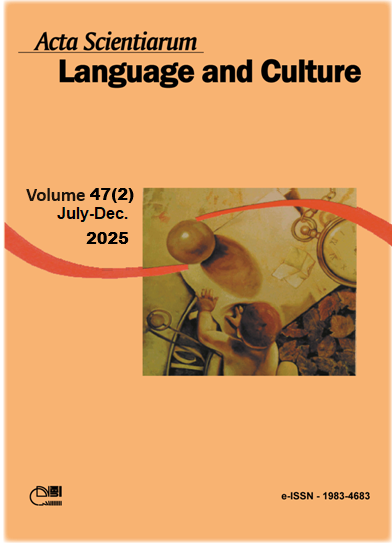How raped women were punished or the pudicitia in Valerius Maximus
Abstract
This paper discusses the impact of rape on women’s lives, as represented in section 6.1 of Memorable deeds and sayings by the Roman author Valerius Maximus. To do so, we demonstrate the opposition between stuprum and pudicitia – a virtue expected, for the most part, from the female population –, as well as the power conflict between the rapist and the paterfamilias, responsible for the victim. The asymmetry between the reality of female and male victims is also presented. The analysis uses the concept of exemplum, according to ancient authors such as Cicero and Quintilian, and modern ones, such as Rebecca Langlands (2018) and Matthew Roller (2018), in dialogue with Roman laws that concern stuprum, mainly the lex Iulia. The conclusion is that the mere prospect of losing pudicitia leads to some kind of punishment – usually death – also of the woman who is the target of the violence. Male victims tend to be represented as worthy of protection and revenge, either by legal means or by murdering the rapist. On the other hand, death is seen as a better option for women than dishonor, so they commit suicide, demonstrating their uirtus, or are killed by the paterfamilias, who thus protects the family name.
Downloads
References
Caldwell, L. (2015). Roman girlhood and the fashioning of femininity. Cambridge University Press.
Canela, K. C. (2012). O estupro no direito romano. Cultura Acadêmica.
Cícero, M. T. (2014). Discussões tusculanas. (B. F. Basseto, Trad.). Edufu.
Cícero. (2018). Orator. O orador. In A. N. Viccini. Como fazer um orador. Tradução e estudo do Orator de Cícero (pp. 61-185) [Dissertação de Mestrado, Universidade de São Paulo].
Dixon, J. E. (2012). The language of roman adultery [Tese de Doutorado, University of Manchester]. https://pure.manchester.ac.uk/ws/portalfiles/portal/54531574/FULL_TEXT.PDF
Herênio Modestino. (1928). Digesto. In T. Mommsen, Corpus Iuris Ciuilis: Institutiones Digesta. Weidmann. https://archive.org/details/corpusIurisCivilisT1InstitutionesDig/page/n11/mode/2up
Kulawiak-Cyrankowska, J. (2019). The death penalty, the “Marriage Penalty” and some remarks on the utility of Senecan research in the study of Roman Law. Studia Iuridica, 80, 197-214. https://doi.org/10.5604/01.3001.0013.4800
Langlands, R. (2006). Sexual morality in Ancient Rome. Cambridge University Press.
Langlands, R. (2018). Exemplary ethics in Ancient Rome. Cambridge University Press.
López Moreda, S., Harto Trujillo, M. L., & Villalba Álvarez, J. (2003). Introducción, traducción y notas. In Valerio Máximo. Hechos y dichos memorables (p. 7-79, S. L. Moreda, M. L. H. Trujillo, & J. V. Álvarez, Introd. Trad. E notas). Gredos.
Madeira, E. M. A. (2006). Advogadas romanas republicanas. Revista da Faculdade de Direito, 101, 87-107. https://revistas.usp.br/rfdusp/article/view/67700
Nguyen, N. L. (2006). Roman rape: an overview of Roman rape laws from the Republican Period to Justinian’s Reign. Michigan Journal of Gender & Law, 13(1), 75-112. https://repository.law.umich.edu/mjgl/vol13/iss1/3
Pavón Torrejón, P. (2008). Valerio Máximo y la asimetría sexual en la severidad del castigo. Latomus, 67(3), 679-691. http://www.jstor.org/stable/41547548
Plutarch. (1931-1936). Moralia: with an english translation by Frank Cole Babbitt. Harvard University Press; William Heinemann.
Pontes, J. S. (2021). O exercício do horror: modelos de teatralidade trágica nos Excerpta Declamationum de Calpúrnio Flaco e nas Declamationes Minores de Pseudo-Quintiliano [Tese de Doutorado, Universidade Federal de Juiz de Fora]. https://repositorio.ufjf.br/jspui/handle/ufjf/13528
Quintiliano. (2015). Instituição oratória (B. F. Bassetto, Trad., apres. e notas). Unicamp.
Roller, M. B. (2018). Models from the past in Roman culture: a world of exempla. Cambridge University Press.
Silveira, M. D. (2006). A imagem feminina na Moralia: heroísmo e outras virtudes [Dissertação de Mestrado, Universidade de São Paulo].
Skidmore, C. (1996). Introduction. In C. Skidmore. Practical ethics for Roman gentlemen: the work of Valerius Maximus (p. 11-7). Liverpool University Press. http://www.jstor.org/stable/j.ctt5vjfqq.5.
Tito Lívio. (1999). Lucrécia; Virgínia. In M. G. Novak, M. L. Neri, & A. A. Peterlini (Org.), Historiadores latinos: antologia bilíngue (p. 104-123, A. A. Peterlni, Trad.). Martins Fontes.
Ulpiano. (1928). Digesto. In T. Mommsen, Corpus Iuris Ciuilis: Institutiones Digesta. Weidmann. https://archive.org/details/corpusIurisCivilisT1InstitutionesDig/page/n11/mode/2up
Valerius Maximus. (1966). Factorum et Dictorum Memorabilium: libri nouem (2nd ed., K. F. Kempf, Edition). Teubner.
Woodcut Illustration of Chiomara, wife of Orgiagon of Galatia - Penn Provenance Project.jpg. (2024). Wikimedia Commons. https://commons.wikimedia.org/w/index.php?title=File:Woodcut_illustration_of_Chiomara,_wife_of_Orgiagon_of_Galatia_-_Penn_Provenance_Project.jpg&oldid=882978720.
Copyright (c) 2025 Jéssica Frutuoso Mello, Charlene Martins Miotti

This work is licensed under a Creative Commons Attribution 4.0 International License.
DECLARATION OF ORIGINALITY AND COPYRIGHTS
I Declare that current article is original and has not been submitted for publication, in part or in whole, to any other national or international journal.
The copyrights belong exclusively to the authors. Published content is licensed under Creative Commons Attribution 4.0 (CC BY 4.0) guidelines, which allows sharing (copy and distribution of the material in any medium or format) and adaptation (remix, transform, and build upon the material) for any purpose, even commercially, under the terms of attribution.
Read this link for further information on how to use CC BY 4.0 properly.




















6.png)









